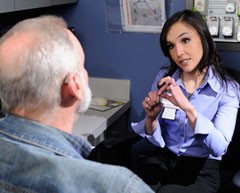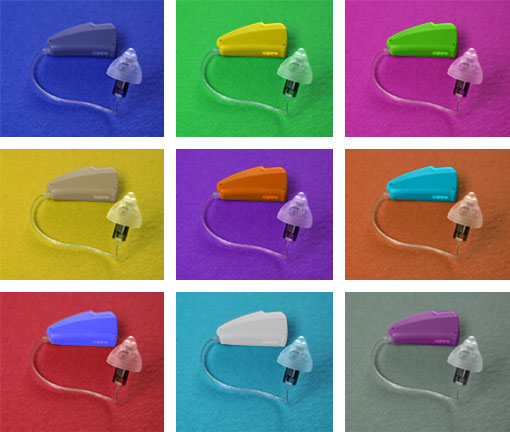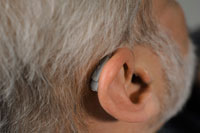High-Tech Hearing Aids Put Seniors Back in the Conversation
By Dorothy Foltz-Gray
 |
Audiologist Cara Snable says that advances in technology have made modern hearing aids virtually undetectable—and have vastly improved sound quality. |
Five years ago, Ida, 68, a widow in Fort Payne, Alabama, began noticing she had to work hard to follow conversations. The pleasure of discussion had become a chore. “I knew someone was speaking, but I was missing words,” she says. “When I couldn’t hear my grandchildren, that motivated me to do something.” At UAB’s Kirklin Clinic, audiologist Cara Snable fitted Ida with tiny hearing units on each ear that have made a big difference in her quality of life.
New audio technologies have shrunk hearing aids to the point that they’re almost undetectable, while sound quality has improved tremendously, Snable says. And that’s good news for the estimated 20 to 40 percent of older adults with some sort of hearing impairment, notes UAB geriatrician Andrew Duxbury, M.D., a professor in the Division of Gerontology, Geriatrics, and Palliative Care.
It’s important to keep in mind that hearing well isn’t a perk—it’s a health necessity, Duxbury says. A person with hearing loss may not detect oncoming traffic as he or she crosses a road, for example. “When people feel less safe, they shrink their world,” says Duxbury. “They stop driving and socializing. If you cannot hear properly, you become isolated from what is going on in the world, from your family, and from your peer group.”
“It Doesn’t Even Look Like a Hearing Aid”
Many older adults are reluctant to seek help because they’re embarrassed to be seen with a hearing aid. But today’s devices are “a lot less noticeable than the large behind-the-ear units used to be,” Snable says. The miniature devices hide behind the ear, while a slim wire slips around to carry amplified sound into the ear.
(Story continues below the graphic)
 |
Today's hearing aids are much less noticeable. The main body of the device above (which is commonly used at UAB) hides behind the ear, with a slim wire carrying amplified sound into the ear itself. Many modern devices are available in a range of colors to match skin tones and hair. But many people opt for vibrant colors because they want the device to stand out, says UAB's Cara Snable. That way, it looks like a Bluetooth headset rather than a hearing aid, she explains. |
“The only thing you see is a tiny wire next to the skin. Even on a man with a short haircut, it’s barely visible,” Snable says. “And aside from traditional skin tones or hair colors, they come in bright colors like green, purple, and red, so they don’t even look like a hearing aid.”
Units that go in the ear “make you feel like your ears are plugged, like you’re hearing things from the bottom of a well,” Snable adds. But the tiny rubber piece that fits into the ear on newer devices allows sound waves to flow in and out more naturally than earlier aids. “It has vents that allow the voice to escape,” Snable says. “It’s closer to having a normal, open ear canal.” Placing the unit behind, rather than in, the ear also protects the unit from moisture, the number-one reason for malfunctions.
Digital Audio
|
Can You Hear Me Now? |
Miniature behind-the-ear aids became popular about eight years ago for people with hearing loss in the higher frequencies, says Snable. (A person with higher frequency loss might be able to hear the lower pitch of a man’s voice better than his wife’s higher-pitched voice, for instance.) The older, in-ear aids trapped low-frequency sounds, but newer devices avoid this problem, Snable notes.
Over the last decade, hearing aids have gone digital, meaning that the sound is processed through a computer chip instead of a simple amplifier. That allows each hearing aid to be customized with user-specific programming. Snable initially set Ida’s aid for a 60 percent hearing adjustment so that her brain could adapt to the new sounds. A few weeks later, Snable reprogrammed it to the full setting that Ida needed.
Most patients remove their aids at night to preserve battery life, Snable says. Batteries cost about $1 apiece and have to be changed roughly once per week; a beep alerts the wearer that it’s time for a replacement.
“Hearing aids now are nearly automatic,” says Snable. “You don’t have to worry about turning the volume up and down. The chip knows the frequency of speech versus background noise, so it can cut out the background noise.”
Ida’s device has brought dramatic results. “Now I can hear leaves blowing, I can hear birds sing, and I can hear myself walking,” she says. “I can hear everything.”
More Information
To make an appointment with a UAB hearing specialist, call 934-0173.
